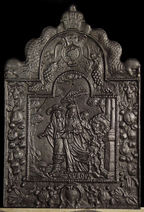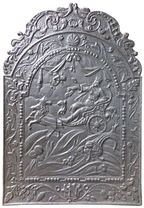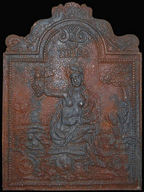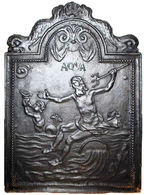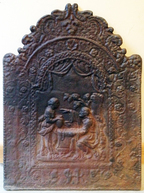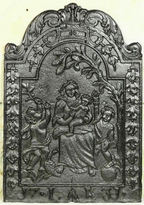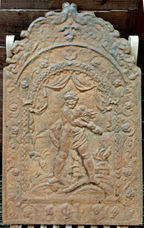-
719
Description: Arched rectangular central panel; bead-and-pellet edging; pictorial scene of a male figure seated in a chariot, his left arm resting on the side of the chariot, his right hand holding a sceptre at arm’s length, the chariot drawn by two lions across a ground with small bushes; clouds above with the personification of the wind blowing to the left; arched rectangular border with fillet edging; repeated, linked scroll-work on all sides; on top a vase of fruit between two mirrored serpents; on each side, rectangular extension panel with a curved top copying the side borders.
Notes: A variant has no extension panels; similar to other designs incorporating figures in chariots, though not from the same series.
- Decoration tags:
- 'Dutch' (shape)
- fillet (edging)
- whole carved pattern
- extension panels
- pictorial
- allegorical
- humans
Manufactured: in the early-18th century in England.
Current location: not known.
- Attached to series:
- British 'Dutch' style firebacks
-
720
Description: Arched rectangular central panel with bead-on-fillet edging, pictorial representation of a man and woman walking, behind the woman a child holds her train and a young person carries a parasol; from behind a column on the right, a horse's head is visible, a tree stands to the left, at the foot of the scene is the word 'EVROPA'; tall-arched rectangular border with fillet edging; at top of arch, a lion's head above a ring, with descending grape vines on each side; at each side, a festoon of fruit suspended on a ribbon from a lion's head; at the bottom, an oval cartouche between flowers; on top, a Holy Roman Imperial crown between two descending dolphins.
Notes: The pictorial scene is based on an engraving c.1642 of Friedrich Wilhelm, Elector of Brandenburg, and his wife, Luise Henriette of Oranje-Nassau, by Mathias Czwiczek; one of series of firebacks depicting allegories of the four continents.
Copies of this fireback are known.
Inscription: EVROPA
- Decoration tags:
- 'Dutch' (shape)
- fillet (edging)
- whole carved pattern
- pictorial
- architectural
- text
- humans
- plants
Manufactured: in the mid- to late-17th century in the Siegerland area of Germany.
Current location: not known.
- Attached to series:
- 'Dutch' Miscellaneous Firebacks
- 'Dutch' Continents firebacks
-
63
Description: 'Dutch' style; arched rectangular central panel, bead edging, a partially clothed female figure holding a wreath in her left hand and a bunch of flowers in her right hand, a circlet of cloth hanging from her right shoulder; arched rectangular shaped border with fillet edging and floral swags suspended; on top, flowers and swirled foliage.
Notes: The figure is an allegorical representation of Agriculture, one of the Iconologia originally published by Cesare Ripa in 1613. A damaged recasting is in Farnham Museum. The 'W' initial probably denotes the pattern maker.
Inscription: W
- Decoration tags:
- 'Dutch' (shape)
- fillet (edging)
- whole carved pattern
- pictorial
- allegorical
- humans
- plants
- objects
Manufactured: in the late-17th to early-18th century in England.
Current location: not known.
- Attached to series:
- British 'Dutch' style firebacks
- Agriculture firebacks
- W series
-
904
Description: Arched rectangular shaped central panel with five-bead and open pellet edging; pictorial: regal figure in his chariot drawn by two horses, a sceptre in his right hand; above, a putto descends from swagged curtains and a pair of tassels; below is a landscape with a cornucopia; arched rectangular shaped border with fillet edging, a scallop shell top centre with symmetrical arrangement of ivy and acanthus leaves and tendrils; the initial, N, in a cartouche bottom centre, between symmetrical oak fronds, leaves and acorns; above is a symmetrical design of scrolled floral tendrils terminating in sea monsters.
Notes: Very similar in design and execution to firebacks of the SHR and EB series, suggesting designs emanating from the same source and with a similar inspiration. The figure in the chariot may be an allegory of the Sun.
Inscription: N
- Decoration tags:
- 'Dutch' (shape)
- fillet (edging)
- whole carved pattern
- allegorical
- animals
- humans
- plants
- objects
Manufactured: in the early-18th century in England.
Current location: not known.
- Attached to series:
- N series
- British 'Dutch' style firebacks
-
948
Description: Arched rectangular shaped central panel with bead edging; seated, semi-naked female figure, with laurels leaves about her head, holding a bunch of grapes in her raised right hand; she is sitting on a stool; to her right is what appears to be a pile of stones; to her left a vase of tulips with a tree behind; above centre, is the word TERRA (earth - Latin); above is a swag of drapery enclosing a scallop shell; outside the panel is a narrow border of the same shape with fillet edging; the fireback is surmounted by a scallop shell between two outward-facing sea serpents.
Notes: One of a series of four designs of the classical elements of Earth, Air, Fire and Water.
Copies of this fireback are known.
Inscription: TERRA
- Decoration tags:
- 'Dutch' (shape)
- whole carved pattern
- pictorial
- allegorical
- text
- humans
- plants
Manufactured: in the mid- to late-17th century possibly in the Siegerland area of Germany.
Current location: not known.
- Attached to series:
- 'Dutch' Miscellaneous Firebacks
- Elements firebacks
-
947
Description: Arched rectangular shaped central panel with bead edging; naked figure of Poseidon/Neptune holding a a trident in his raised left hand, his right arm extended; he is sitting on a bridge over a flowing stream; to his right a merman, half immersed, blows a shell trumpet; above centre, is the word AQUA (water - Latin); above is a swag of drapery enclosing a scallop shell; outside the panel is a narrow border of the same shape with fillet edging; the fireback is surmounted by a scallop shell between two outward-facing sea serpents.
Notes: One of a series of four designs of the classical elements of Earth, Air, Fire and Water.
Copies of this fireback are known.
Inscription: AQUA
- Decoration tags:
- 'Dutch' (shape)
- fillet (edging)
- whole carved pattern
- pictorial
- mythological
- allegorical
- text
- humans
- objects
Manufactured: in the mid- to late-17th century possibly in the Siegerland area of Germany.
Current location: not known.
- Attached to series:
- 'Dutch' Miscellaneous Firebacks
- Elements firebacks
-
984
Description: Arched rectangular central panel with additional arch above; bead and fillet edging; pictorial scene of, on the left, a tree next to a female and, in the centre, a male figure, both in eastern dress, a page behind holding a train, and to the right a short obelisk surmounted by a crescent, behind which is the head of a figure with a camel; behind is a small building also surmounted by a crescent, with clouds above; the word, ASIA, is centre bottom; identical shaped border with cavetto-moulded edging; a pomegranate on top with descending swags of drapery; at the sides, overlapping bunches of foliage suspended from ribbon bows; at the bottom, a central cartouche between fruit bunches; on top, a pomegranate with a descending serpent on each side, and a pomegranate on each shoulder of the plate.
Notes: A pastiche of the EUROPA design based on an engraving c.1642 of Friedrich Wilhelm, Elector of Brandenburg, and his wife, Luise Henriette of Oranje-Nassau, by Mathias Czwiczek, with the figures adopting very similar poses in an oriental setting; one of series depicting allegories of the four continents, in this instance Asia. A recasting.
Copies of this fireback are known.
Inscription: ASIA / MB
- Decoration tags:
- 'Dutch' (shape)
- fillet (edging)
- whole carved pattern
- pictorial
- allegorical
- monogram
- text
- animals
- humans
Manufactured: in the mid- to late-17th century possibly in the Siegerland area of Germany.
Current location: not known.
- Attached to series:
- 'Dutch' Arched arch types
- 'Dutch' Continents firebacks
-
1220
Description: Arched rectangular shaped central panel with hollow bead edging; to the right, a seated male figure beside a wellhead, pointing towards a standing female resting a ewer on the wellhead over which a rope hangs, and behind the male figure is a tree, and above, swagged drapery; arched rectangular shaped border with fillet edging; swirled flowers and tendrils symmetrically arranged, with SHR monogram at centre bottom; two mirrored stylised sea serpents on top; to each side a vertical extension with bead edging, of the same decoration as the side borders.
Notes: The frame of the central panel and the enclosing border are identical to those noted on another fireback displaying a figure of Pluto (see fireback no. 164), while the pictorial scene, of Jesus and the Woman of Samaria (St John 4: 5-28) is more typical of continental firebacks and stoveplates. This may be an example of an image from one casting being superimposed within the frame of an earlier fireback. The central image is sharper than the surrounding border.
Inscription: SHR
- Decoration tags:
- 'Dutch' (shape)
- bead (edging)
- whole carved pattern
- extension panels
- pictorial
- biblical
- monogram
- text
Manufactured: in the late-17th to early-18th century in England.
Current location: not known.
- Attached to series:
- British 'Dutch' style firebacks
-
1017
Description: Arched rectangular central panel with fillet edging; central seated female with an infant in her arms, a swan at her feet and a standing child on each side, the one to her left facing the front and holding aloft a flaming heart, its foot on a ball; the child to her right facing the woman, holding aloft a branch in its left hand, all on a ground with an overhanging tree to the right; arched rectangular border with fillet edging with descending festoons of acanthus flowers on each side, the date and initials at the bottom and, at the top on each side, a pair of acanthus flowers descending from a heart-shaped terminal of a strapwork frame; above, mirrored swirls of foliage.
Notes: The central pictorial scene is a crude pastiche of a panel portraying an allegory of Charity frequently used on firebacks produced in the Siegerland of north-west Germany for the Dutch market in the second half of the seventeenth century. The swirled foliage on the top is typical of English 'Dutch' style firebacks of the early-eighteenth century and the numerals are also more typically English in style.
Inscription: 17 . IAK[?] 31
- Decoration tags:
- 'Dutch' (shape)
- fillet (edging)
- whole carved pattern
- individual letters
- individual numbers
- allegorical
- text
- humans
- plants
Manufactured: in 1731 in England.
Current location: not known.
- Attached to series:
- Charity firebacks
- British 'Dutch' style firebacks
-
164
Description: Arched rectangular shaped central panel with hollow bead edging; draped male figure standing on undulating ground with two small trees, holding a bar, flaming furnaces behind, drapery suspended from above; Arched rectangular shaped border with fillet edging; swirled flowers and tendrils symmetrically arranged, with monogram at centre bottom; symmetrical arrangement of foliage on top.
Notes: The figure is of Pluto, one of a set of 'Eight Deities' engraved by Hendrick Goltzius (1592), after Polidoro da Caravaggio; a recasting, there is a larger (420mm x 640mm) but more corroded version in Hastings Museum. The faint initials SHR are probably those of the pattern-maker. The image is of a copy; original castings are fractionally larger.
Copies of this fireback are known.
Inscription: SHR
- Decoration tags:
- 'Dutch' (shape)
- fillet (edging)
- whole carved pattern
- mythological
- monogram
- humans
Manufactured: in the late-17th to early-18th century in England.
Current location: not known.
- Attached to series:
- SHR series
- British 'Dutch' style firebacks
- Eight Deities series

